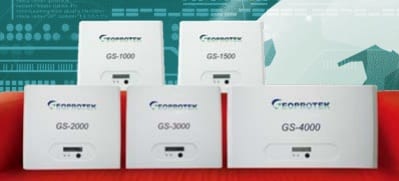 If you experience an issue on a Geoprotek Solar Inverter, the manual shutdown procedure is useful in fixing some errors. There are also other faults that require other procedures. For convenience, we have put together a list of error messages, possible causes and remedies. If you are not very keen in performing the procedures below, we recommend that you contact a qualified electrician to avoid any injury, data loss or system crash.
If you experience an issue on a Geoprotek Solar Inverter, the manual shutdown procedure is useful in fixing some errors. There are also other faults that require other procedures. For convenience, we have put together a list of error messages, possible causes and remedies. If you are not very keen in performing the procedures below, we recommend that you contact a qualified electrician to avoid any injury, data loss or system crash.
View the Geoprotek Solar Inverter user manual here.
|
Error Message |
Possible cause |
Remedy |
| Grid Fault | The grid voltage or frequency is out of the permitted range. | •The GS INVERTER will reset automatically when the grid returns to normal operation.•Test the grid voltage, frequency, and grid Connection on GS INVERTER.
•Make sure grid voltage and frequency meet the specifications. •If the grid voltage is within the acceptable range, but the error is still displayed, discuss the proposed parameters with the service line. |
| PV Over Voltage | The DC input voltage at the GS INVERTER is too high. | •Disconnect the GS INVERTER from the PV array immediately.• Check the DC voltage of the strings to ensure that they comply with the maximum input voltage of the GS INVERTER before connecting it to the PV array again. |
| Ground I Fault | The leakage current of the GS INVERTER and the PV array is too high. This can be caused by a sudden fault in the connection to ground, a fault current or a malfunction. | •Check the strings for ground faults. Unplug the PV array from the DC-input, check the AC peripheral system.•After the cause is cleared, plug PV in again and check the status of Inverter. |
| Isolation Fault | Earth leakage or insulation fault on the DC side. Or phase and neutral conductor interchanged. | •Check PV array and DC cabling.•Check the phase on the AC mains supply.
•Check the impedance between the DC (+) and DC (-) and earth ground. The impedance must be larger than 8MΩ. •If the error is still displayed, please contact the service line. |
| Over Temperature | The internal temperature of GS INVERTER is too high Insufficient air circulation | •Ensure air can circulate at the side of the GS INVERTER.•improve ventilation around the inverter.
•If it is not effective, the temperature sensors fails, please contact the service line. |
| No Utility | Grid is not connected; check the AC connection by multi-meter. | • Check AC installation and grid connection.• Check whether there is a general power failure.
• Check breaker between inverter and grid; if it is tripped, DO NOT CLOSE again, replace the inverter. |
| Impedance Fault | The grid impedance at the connection point of the GS INVERTER is too high. | •Observe the error for 30 seconds, check if it works normally.•Check the wires between inverter and grid. Change larger wires if necessary.
•If the error is still displayed, please contact the service line for further assistance. |
| Consistent Fault | It may cause by the reading difference between main and redundant controllers. | •Switch off the DC isolator switch and PV array isolators.•Switch off solar supply main switch.
•Disconnect DC (+) and DC (-) from the input for one minute and reconnect it again. •Switch on the solar supply main switch. •Switch on the DC isolator switch and PV Array isolators. •If it does not work, please contact service line. |
| DC CurrMismatch | The reading difference of output DC current between main and redundant controllers. | |
| GFCI Mismatch | The reading difference of GFCI value current between main and redundant controllers. | |
| Grid V Mismatch |
The reading difference of Grid V between main and redundant controllers. | |
| Grid F Mismatch |
The reading difference of Grid F between main and redundant controllers. | |
| Grid Z Mismatch |
The reading difference of Grid impedance between main and redundant controllers. | |
| Sci Fault | Communication error between main and redundant controllers. | |
| CPU Ver Mismatch |
The reading difference of firmware version between main and redundant controllers. | |
| Device Fault | It may be caused by improper operation of the circuit. | •Switch off the DC isolator switch and PV array isolators.•Switch off solar supply main switch.
•Disconnect DC (+) and DC (-) from the input for one minute and reconnect it again. •Switch on the solar supply main switch •Switch on the DC isolator switch and PV Array isolators. •If it does not work, please contact service line |
| Relay Failure | It may be caused by the failure of output relay. | |
| DC INJ High | It may be caused by the DC output injection was too high | |
| Ref 2.5V Fault | 2.5V reference voltage inside problem | |
| DC Sensor Fault | It may be caused by the abnormal of DC output sensor. | |
| GFCI Fault | GFCI detection problem | |
| EEPROM Fault | EEPROM problem | |
| DC Bus High | It may cause by the voltage of DC bus was too high. | |
| DC Bus Low | It may cause by the voltage of DC bus was too low. |
If you need more information, the full details are available in the Geoprotek Solar Inverter manual’s Troubleshooting section. Check if your Geoprotek Solar Inverter is still within the warranty period so you can contact the equipment installer or supplier for repair if the error continues. If your inverter is outside the warranty period we suggest that you contact a professional solar power expert. If you’re in the Gold Coast or Brisbane area contact Gold Coast Power Solutions here and we will be in touch to provide you with further assistance.
View the Geoprotek Solar Inverter user manual here.

Got A Question About Solar Power?
Click Here For Answers!
- Can you add more solar panels to your solar power system?
- How much power can you expect from your solar power system?
- Do you know how to read your Energex solar power meter?
- How to make the most of the 44c feed in tariff
- How to make the most out of a low feed in tariff



